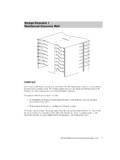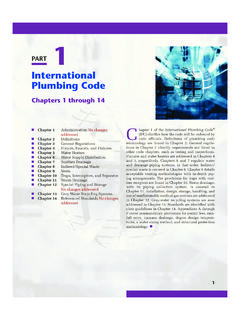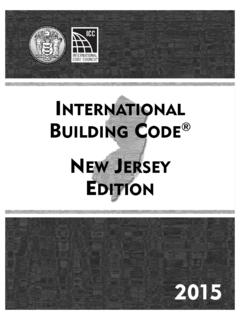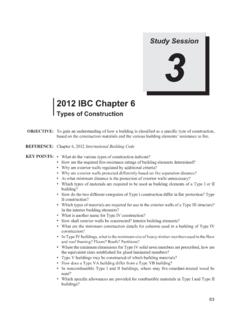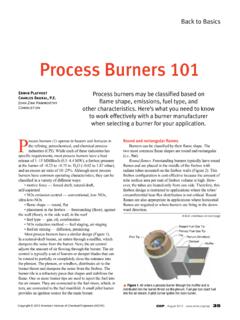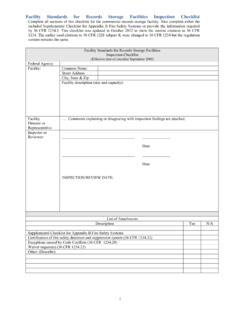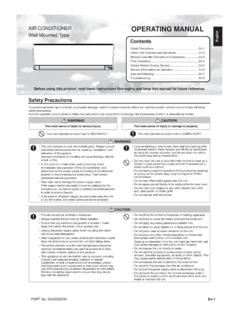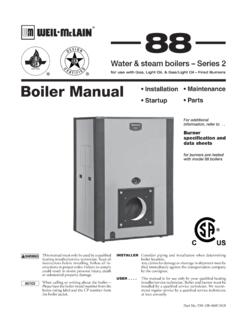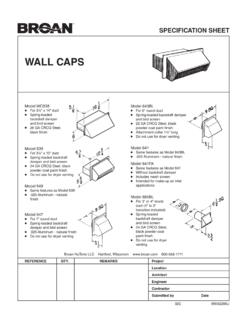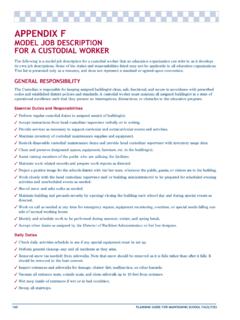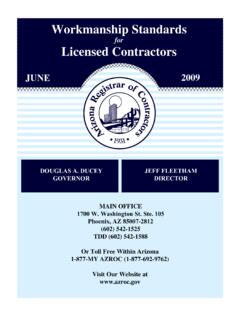Transcription of 2018 IRC Sections R303 through R310 - iccsafe.org
1 57 Study Session3 2018 IRC Sections R303 through R310 Building Planning IIOBJECTIVE:To develop an understanding of the health and safety criteria of the code, including lightand ventilation; minimum room areas and ceiling height; sanitation; toilet, bath, andshower spaces; glazing, including safety glazing; carports and garages; and emergencyescape and rescue : Sections R303 through R310, 2018 International Residential Code KEY POINTS: Where natural light is used to satisfy the minimum illumination requirements, how is the minimum required amount of glazing determined? Where artificial light is used, what illumination level is mandated? Under what conditions is a whole-house mechanical ventilation system required? How must mechanical and gravity outside air intake openings be located in relation-ship to vents, chimneys, parking lots and other potential areas of a hazardous or nox-ious contaminant? Where must illumination be located in relationship to interior stairways?
2 Exterior stairways? In what climatic areas must a heating system be provided? What performance level is mandated for the system? What is the minimum required size of the largest habitable room in a dwelling unit? What is the minimum dimension permitted for a habitable room other than a kitchen? What is the minimum ceiling height permitted for a living room or bedroom? A hall-way? Bathroom? Basement? Where can a reduction in such heights be acceptable? How much clear floor space is required in front of a water closet? In front of a shower opening? What is the minimum distance needed between the centerline of a water closet and the nearest adjoining obstruction such as a wall or shower compart-ment? In what manner must safety glazing be identified? Multipane assemblies?582018 IRC Study CompanionKEY POINTS:(Cont d) What test standards are applicable to safety glazing materials? Which test standard is acceptable for glazing installed in any hazardous location?
3 What specific locations in and adjacent to doors are subject to human impact and require safety glazing? In tub and shower areas? In guards and railings? At stairways and stairway landings? When is sloped glazing considered a skylight? What glazing materials are permitted in skylights? When must a screen be installed below a skylight? How does a carport differ from a garage? What limitations are placed on carports? Where are escape and rescue openings required? What is the minimum size of such openings? Maximum sill height? What limitations are placed on the operation of the opening? When a window well serves an escape and rescue opening, what is its minimum size? How may a bulkhead enclosure be utilized as an escape and rescue opening? Under what conditions may an emergency escape window be located under a deck or porch?Study Session 359 Topic: Habitable RoomsCategory: Building PlanningReference: IRC : Light, Ventilation and HeatingCode Text:Habitable rooms shall have an aggregate glazing area of not less than 8 percent of thefloor area of such rooms.
4 Natural ventilation shall be through windows, skylights, doors,louvers or other approved openings to the outdoor air. The openable area to the outdoorsshall be not less than 4 percent of the floor area being ventilated. Exceptions allow theuse of artificial light and mechanical andCommentary:A usable and sanitary interior environment depends on the inclusion of adequate light andventilation for the habitable spaces within the dwelling unit. Traditionally, the use of nat-ural light and, to some degree, natural ventilation has been mandated as the means forachieving such an environment. It has become increasingly more common to use artificiallighting and a mechanical ventilation system. These methods create additional designflexibility and functionality while maintaining a pleasant and sanitary living the mechanical ventilation option is used for bathrooms and water-closet compartments,the minimum ventilation rates are set forth for either continuous ventilation or intermittent ventila-tion.
5 In both cases, the air must be exhausted directly to the exterior of the 0 @ 15 1 7 + &@ / !0 ) @ , $- $, 5 A 602018 IRC Study CompanionTopic: Intake and Exhaust OpeningsCategory: Building PlanningReference: IRC , : Light, Ventilation and HeatingCode Text:Mechanical and gravity outdoor air intake openings shall be located not less than 10 feet(3048 mm) from any hazardous or noxious contaminant, such as vents, chimneys, plumb-ing vents, streets, alleys, parking lots and loading docks. See the exceptions, including#1, which allows for a lesser separation provided the intake opening is located at least 3feet below the contaminant source. Exhaust air shall not be directed onto andCommentary:In the context of this section, intake openings include windows, doors, combustion airintakes and similar openings that naturally or mechanically draw in air from the buildingexterior. The alternative to the 10-foot separation requirement, a 3-foot vertical separationdistance, will allow noxious gases and contaminants to disperse into the atmospherebefore they can be drawn into an air intake air exhaust and intake openings are regulated in the same manner as other openings inexterior walls.
6 As such, they are not permitted in walls having a fire separation distance of lessthan 3 feet, except in exterior walls that are perpendicular to the lot Session 361 Topic: Stairway IlluminationCategory: Building PlanningReference: IRC , : Light, Ventilation and HeatingCode Text:Interior stairways shall be provided with an artificial light source to illuminate the land-ings and treads. See the exception where remote, central or automatic control of lightingis provided. Where lighting outlets are installed in interior stairways, there shall be awall switch at each floor level to control the lighting outlet where the stairway has six ormore risers. See the exception for lights that are continuously illuminated or automati-cally controlled. Exterior stairways shall be provided with an artificial light sourcelocated at the top landing of the andCommentary:A stairway is one of the most hazardous areas of a dwelling unit.
7 As such, the code highlyregulates the design and construction of all stairways. In addition, adequate lighting mustbe provided to enable the stairway user to see the treads, their nosings and any obstruc-tions that may be present. Stairway landings must also be adequately the light sources are on continuously or automatically activated, interior stairway lightsmust be controlled from both the top and bottom of each stairway consisting of six or more exterior stairway lighting, the control switch is to be located within the dwelling unit. ! B B 622018 IRC Study CompanionTopic: Minimum Areas and DimensionsCategory: Building PlanningReference: IRC R304 Subject: Minimum Room AreasCode Text:Habitable rooms shall have a floor area of not less than 70 square feet ( m2). Habit-able rooms shall not be less than 7 feet (2134 mm) in any horizontal dimension. See theexceptions for kitchens regarding minimum size and horizontal andCommentary:Acceptable sizes for habitable rooms have been established.
8 Because habitable rooms areexpected to be those spaces within a dwelling unit where most activities take place, theyare the only areas regulated. Most habitable rooms need be only 7 feet by 10 feet to com-ply with the provisions; however, at least one larger room must be provided. It is seldomthat any habitable room in today s typical dwelling unit would be designed with such asmall floor minimum required floor area for any habitable room having a sloping ceiling, as would typi-cally be encountered where an attic area is finished for use as a living or sleeping area, must bebased on only those portions of the room with a ceiling height of at least 5 SI: 1 degree = radStudy Session 363 Topic: Minimum HeightCategory: Building PlanningReference: IRC , : Ceiling HeightCode Text:Habitable space, hallways and portions of basements containing these spaces shall havea ceiling height of not less than 7 feet (2134 mm). Bathrooms, toilet rooms and laundryrooms shall have a ceiling height of not less than 6 feet 8 inches (2032 mm).
9 See theexceptions addressing rooms with sloped ceilings, bathrooms and basements. Portions ofbasements that do not contain habitable spaces or hallways shall have a ceiling height ofnot less than 6 feet 8 inches (2032 mm). See the exception allowing beams, ducts and sim-ilar obstructions to project to within 6 feet 4 inches of the finished andCommentary:For both safety reasons and usability by the occupants, the minimum ceiling heightthroughout occupiable areas of a dwelling unit is regulated. Most rooms that are com-monly used by the occupants are included, other than closets and storage areas. Wherebasements are used for habitable purposes, they too must comply with the minimumheight requirement of 7 different minimum ceiling heights are applicable to basements. In habitable spaces andhallways, the minimum required height is 7 feet. Other areas of the basement only need a mini-mum ceiling height of 6 feet 8 inches.
10 Where beams, ducts and other obstructions exist, a head-room clearance of 6 feet 4 inches is #C 5 ; > - %C &1 5 $ 4 %C D1 E 642018 IRC Study CompanionTopic: Minimum Space RequiredCategory: Building PlanningReference: IRC R307 Subject: Toilet, Bath and Shower SpacesCode Text:Fixtures shall be spaced in accordance with Figure and in accordance with therequirements of Section Bathtub and shower floors and walls above bathtubswith installed shower heads and in shower compartments shall be finished with a nonab-sorbent surface. Such wall surfaces shall extend to a height of not less than 6 feet (1829mm) above the andCommentary:It is necessary to provide adequate clearances at and around bathroom fixtures to allowfor ease of use by the occupants of the dwelling unit. The code addresses clear floor spaceand clearances for lavatories, water closets, bathtubs, and showers. In addition, the mini-mum permitted size for a shower is 30 inches by 30 inches with a clearance of at least 24inches provided in front of the shower need for nonabsorbent surfaces in shower areas subject to water splash is based on twoconcerns.
